  
|
Butterfly Tuning
Basic Race and Performance Sailing Tuning Guide
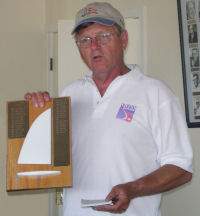 By
Jim Young
By
Jim Young
(Jim has won more Nationals titles than anyone in the history of the class. Many of his wins, including the 3 back-to-back titles of '88, '89, and '90, were on borrowed boats, so he has history of being able to step on to a new boat, do a little fiddling with it, and making it fast. He is a very successful sailing coach, was on the staff of the 1984 US Olympic Team and was Head Coach of the Swiss Sailing Team for many years, including the Barcelona and Atlanta Olympics. Most recently, he was a coaching consultant to Swiss Sailing leading up to the Athens Olympics. He is now a private coach and consultant, specializing in youth programs, around the world.)
The Butterfly is a wonderfully simple boat, safe and easy to sail. The most important ingredient when trying to make to boat sail well is knowing how to sail, and spending time practicing those skills. However, because sailing is a mix of physical skills and the mechanics of setting up the boat, there are always questions about the magic art of "tuning", setting up the boat so it will go fast in spite of the sailor.
The Butterfly is easy to set up, and forgiving of a wide range of adjustments. What follows is a basic guide; there are some experienced sailors who set up a little differently, but their speed with those setups is a result of practice and experience, not the tuning alone.
Starting with the hull, as with any modern fiber-plastic boat, it is best to keep it clean and smooth. Whether to wax or not is up to the sailor. A waxed boat will stay cleaner, and thus sail faster, in dirty waters, and will be easier to slide on and off shoreline docks. If the boat is not waxed, it should be cleaned regularly with a fiberglass boat cleaning compound. Experts may argue about whether waxing or a clean wet-sanded hull (with #600 wet/dry paper, using lots of water to keep it wet) is faster. In a boat as small as a Butterfly, it does not matter which is done, as long as the hull is clean and smooth. (Wet sanding with #600 paper is also the way to take out the normal small scratches that appear over the years, to keep the hull smooth.)
The centerboard needs a little attention. The goal is to have it clean and smooth, just like the hull, so wet-sanding is the usual answer. If it gets minor dings or the edges chewed up, especially the trailing edge, touch up the finish with a good marine varnish - I have had great success in recent years with a spray varnish, Helmsman Spar Urethane - and wet-sand when its dry. You may have to start out with #400 paper used wet to fair in the new varnish to the old finish, but finish off with #600. On major dings, use a polyester boat putty filler, sand smooth and varnish over it.
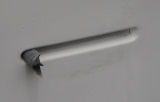 If
the boat hums a lot, it is from vibration of the board. This is not caused
by the board, it is because of lumps and bumps of gelcoat just inside
the bottom of the boardbox. Use a flat file on bad lumps, then find someone
with skinny fingers to sand inside. It is not necessary to get far in,
the problem spots are usually in the first inch. The photo here shows
a piece of 400 wet/dry sandpaper curled to sand inside the end of the
board slot on the bottom.
If
the boat hums a lot, it is from vibration of the board. This is not caused
by the board, it is because of lumps and bumps of gelcoat just inside
the bottom of the boardbox. Use a flat file on bad lumps, then find someone
with skinny fingers to sand inside. It is not necessary to get far in,
the problem spots are usually in the first inch. The photo here shows
a piece of 400 wet/dry sandpaper curled to sand inside the end of the
board slot on the bottom.
The last part of the boat in the water, the rudder, is of aluminum, and generally needs little attention other than keeping it clean. It is virtually never waxed. Sand out little dings or dents on the edges. The most important edge is the back edge, keep it straight, clean, and the corners of the flat edge sharp. Don't try to sand the back edge to round or taper it; not only is it not allowed under the rules, a small square edge with sharp corners will be technically faster. Other rudder details; if it kicks up too easily, or not at all, tighten or loosen the center pivot bolt. First loosen the nut, then use a screwdriver on the head, but go easy, it usually only takes 1/2 turn to make a big difference. Remember to tighten the nut when done. The last item is the pivot assembly; if you sail regularly in salt water or off a fine sand beach, flush the pivot area regularly with fresh water.
The boat normally sails with both the board and rudder blade all the way down. The rudder says down all the time, but the board is changed for different angles of sailing. When going upwind, it is all the way down in all winds, unless the sailor is a real lightweight and is feeling overpowered. Then pulling it up a bit, 2 or 3 inches, is another way, along with flattening the sail, to de-power. When reaching, up 6 inches or so is usually good enough. For downwind, it should be only up far enough to still fill the bottom of the board box. Pulling it up more is usually a mistake, opening that big hole in the bottom of the boat is slower than keeping a little bit of board sticking out from the hull. That little bit of board also helps with downwind steering. (Hint: Tip the boat over on land and put the board in, with the curved edge forward. From the bottom, push the board up until the curve of the board just begins to disappear into the slot. Then go around the the top of the boat and make a magic-marker line on the board at the deck line. Never pull the board up beyond that line.)
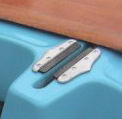 All
boats made in the past quarter-century have a "snubber' on top of
the board box to hold the board in place, both up, and down - and to help
keep it in place in a capsize. The rubber lips do age and wear out, check
yours to see if they need replacing. If you have an older boat without
a snubber, its one of the essential additions to bring your boat up to
date.
All
boats made in the past quarter-century have a "snubber' on top of
the board box to hold the board in place, both up, and down - and to help
keep it in place in a capsize. The rubber lips do age and wear out, check
yours to see if they need replacing. If you have an older boat without
a snubber, its one of the essential additions to bring your boat up to
date.
Getting to the top of the boat, the tiller handle is no problem, just keep it varnished to look nice. If it rubs on the deck, take a look underneath the handle where it fits the rudder head; there is a small nylon spacer there. Either pull it off and put a stainless steel washer underneath it, or for a quick fix, put a couple strips of tape over the rudder stop where the nylon spacer hits. For a permanent fix, go to a hardware store and get some taller 'chair glides' and replace the short one that comes with the rudder. The tiller extension is an area to pay a little attention to. I prefer an extension longer than standard; the nice little adjustable ones are great but expensive and heavy, I now make my own, the maximum length that works without getting caught in the bridle wire or mainsheet and with a great swivel joint that doesn't jump out of your hand.
The reason for a longer extension is only partly to hike more comfortably in heavy air, it is also to allow the skipper to get more forward in light air. As I noted above with my own extension, be careful with the length, if it is too long it will hang up on the bridle wire or mainsheet. (Hint: If you use an adjustable extension, mark the shaft with tape at the length where the extension can go back to - but not past - the bridle, and never let it get longer than that so it does not foul in the bridle or sheet lines.)
Now for the mast. First, with it on the ground, check the side stays to be sure they are the same length. If they are not, don't panic to change them, just set the stay adjusters on the sides to different holes to compensate. Now, set the boat flat, on a trailer or sawhorses or block it sitting on the beach or lawn. Flat means having the rubrail horizontal. With the boat in this position, the mast should stand straight up when looking from the side. The controlling adjustment is the forestay. When the mast is vertical, adjust the side stays so that the mast can just be rotated by hand to 'almost' 90 degrees. This will be fairly tight, you may need someone to push on the mast to get the last adjuster pin in place. Don't get paranoid about this setup process, a hole or two off on the adjusters will make no noticeable difference for most sailors. If you make a mistake, try to be more aft that forward with rake, going forward from vertical produces some very unpredictable rudder actions!
The mast rake is where there is the biggest difference among the boats. And this is where skill and experience fit in. As the sailor gets better at boat handling, the mast rake aft can be increased. This allows for the potential for more speed. BUT this speed can only be realized if the boat handling and sail handling are good. Unless you have really good skills - that means a very good feeling for how both sail trim and angle of heel affect rudder pressure - in all winds, it can be a big mistake to rake back more than a couple holes on the adjuster. Any increase in rudder pressure will only slow the boat down.
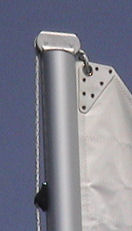 Now
the sail. When the mast went up, the main halyard should have been in
place. There is a hook molded in the front of the aluminum mast head on
older masts, or a black clam cleat on newer ones. With the hook, use a
knot in the
Now
the sail. When the mast went up, the main halyard should have been in
place. There is a hook molded in the front of the aluminum mast head on
older masts, or a black clam cleat on newer ones. With the hook, use a
knot in the 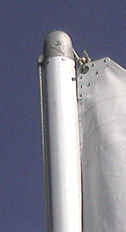 halyard
to hold the sail up. With the boat on land, tip the boat over to look
at this hook/knot arrangement, and also at the top of the sail. Make a
mark on the halyard where the sail has to be tied in order to get the
sail all the way up to the top of the mast when the knot is in the hook.
(A hint for recreational sailors in strong winds: Tie a second knot in
the halyard, about 4 inches from the first, and use this knot in the hook
in strong winds to lower the sail. It makes the boat much more controllable
when its blowing hard. But if you are a racer, don't do it - the National
Butterfly Association has ruled that having the sail lower is a basic
violation of one-design sailing principles, which is simply that all boats
are as alike as possible, and that the only variable is sailor skill.)
For masts with the clam cleat, its easier, simply tie the halyard on the
head of the sail with a good knot, hoist the sail, and lay the halyard
in to the cleat. For recreational sailors strong winds, simply don't hoist
the sail all the way.
halyard
to hold the sail up. With the boat on land, tip the boat over to look
at this hook/knot arrangement, and also at the top of the sail. Make a
mark on the halyard where the sail has to be tied in order to get the
sail all the way up to the top of the mast when the knot is in the hook.
(A hint for recreational sailors in strong winds: Tie a second knot in
the halyard, about 4 inches from the first, and use this knot in the hook
in strong winds to lower the sail. It makes the boat much more controllable
when its blowing hard. But if you are a racer, don't do it - the National
Butterfly Association has ruled that having the sail lower is a basic
violation of one-design sailing principles, which is simply that all boats
are as alike as possible, and that the only variable is sailor skill.)
For masts with the clam cleat, its easier, simply tie the halyard on the
head of the sail with a good knot, hoist the sail, and lay the halyard
in to the cleat. For recreational sailors strong winds, simply don't hoist
the sail all the way.
The sail controls are the out- and down-hauls, the boom vang, and the mainsheet. The 'hauls' first; both are set too tight by most sailors. Adjust until there are no wrinkles when sailing, vertical wrinkles above the boom for the outhaul and horizontal wrinkles off the mast for the downhaul, then EASE them both a little, so that wrinkles just begin to appear. These adjustments are made while sailing, not sitting on the beach. Lighter-weight sailors should have the outhaul tighter, especially as the wind increases, and the downhaul should be only used if the sailor is feeling overpowered and is fighting the boat. (A Really Big Hint: Pulling the mainsheet harder flattens the sail - by bending the mast - much better than pulling on the downhaul.) And a note for those of you who like to fiddle with lines, I virtually never touch these controls, especially the outhaul, once a race begins. I might give the downhaul a quick adjustment if there is a BIG change in wind, but only then.
The vang is not the same as a vang on a boat with a non-rotating mast. It should not be set too tight upwind, because it prevents the mast from rotating. There are a few sailors who have had success with the vang tight and no mast rotation, but to make this work they have to take great care to keep the sail full by actually pushing up on the gooseneck and then never touch the downhaul. (A note on the class rules; anything that HOLDS the sail up is not allowed, the only restriction on where the gooseneck slide is in the mast is the downhaul.) This way of sailing the boat is also extremely sensitive to steering and can stall very easily. The vang should be set snug for a reach, and tightest, but not super-tight, downwind. To set the vang for a downwind, tighten it when sailing upwind, BEFORE going on a reach or downwind. Likewise, it is loosened going upwind, AFTER the reach or run. It should be freed enough to allow the mast to rotate, not more. If the vang is too tight upwind, the mast will not rotate when tacking.
The mainsheet is the basic, and most important, speed control. When and how much to adjust it is gained from experience more than anything else. In general, it should be tight upwind, enough to bend the mast a little in moderate wind. In light wind, the sheet should be eased so that the back of the boom is over the leeward corner of the transom. In heavy wind, sheet harder and harder until overpowered, then free it enough to keep the boat flat and under control.
Some other mainsheet thoughts; first, don't get one that is too big for the blocks in the mistaken belief that it is easier to hold. It it can't run easily through the blocks, then you are fighting friction not the load of the sail when pulling it in in strong winds, and it won't go out fast and easily in light winds. I prefer a 7mm sheet, but most sailors seem to be happiest with 8 mm (those are 1/4"+ and 5/16 for those of you who have not yet converted). And one final point, the bridle wire on the back really needs to be in decent condition, replace it if it is worn, twisted, or becoming frayed. And with that comes another Rules warning, the class rules do not say that you can put a block on the wire - so you have two bocks end to end, one on the wire and the other end for the sheet - so don't do it. The Rules only allow specific changes, not anything that is not mentioned.
For angle of heel and body position, in heavy air all the weight should be as far forward in the cockpit as the hiking straps will allow going upwind, and as far back as possible on reaches. Downwind, the weight needs to be forward, but carefully, so the bow does not bury. An exception to weight forward upwind is in waves, when the weight needs to be far enough back, up- and down-wind, to keep the bow out of the next wave. In light wind, in general, the weight should be forward all the time, up on the deck just forward of the cockpit. Since the ideal is just not possible for most body shapes, as far forward as is comfortable will do. In moderate winds, front of the cockpit up- and downwind, and middle on reaches.
With heel, the Butterfly requires compromises. The scow hull sails best heeled over about 15 degrees, but at that angle, the Butterfly's centerboard is sideslipping badly. So the answer is to keep the boat as flat as possible upwind in all moderate winds, heeling only a little to get through waves. In light winds, a little - repeat, LITTLE - heel is OK, helping to keep the boom out and the sail full. Remember, heel means the board doesn't work as well, so the boat sideslips and does not point as high. But this is OK in really light winds, since forward speed is more important than pointing.
In strong winds, some heel is fine since it will help the boat get thru the waves easier, but try to get it flat in any smooth spots in the wave pattern.
Reaching, the boat sails best with the standard scow heel of 15 degrees, the rub rail just touching the water, except in planing conditions when the boat should be sailed flat and fast.
Downwind, the boat should be heeled the normal 15 degrees to leeward in light winds, but whenever there is enough wind to hold the boom out, then the boat should be heeled to windward. If the boat begins oscillating and control gets difficult, simply put down a little more centerboard. Oscillation can also be caused by having the vang too lose, so look up and check to see that the leach of the sail is not too 'open' or curved.
Remember, the most important component on any boat is the sailor. Skill
and experience has made it possible for many boats to win championships,
but never has a fast boat made it possible for an unskilled sailor to
win. Good luck, and have fun.